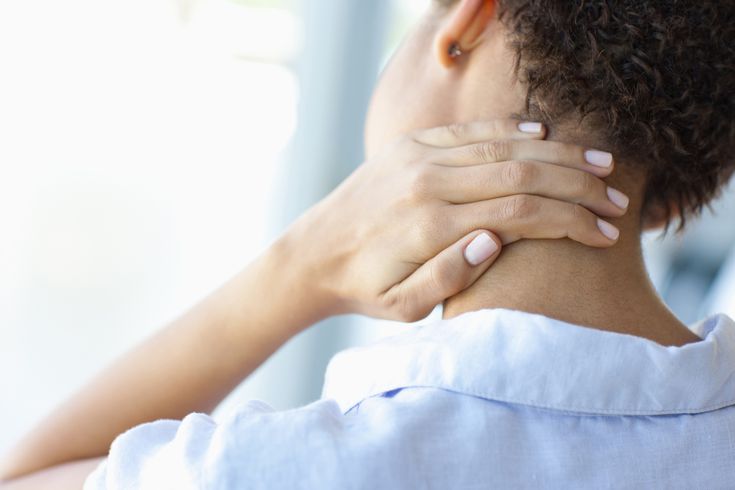We have all suffered from a stiff neck, a crick in the neck, or torticollis. It usually leads to headaches or tight jaws due to the pain. It is also a safety hazard when driving or just walking around. Ever wonder why the automobile industry created the backup camera? While it was originally designed for autonomous cars, it became popular due to drivers not being able to turn their heads when backing up. When out for a walk, I have seen pedestrians nearly step out in front of a car or bike because they could not turn their heads enough to see them. Today, I am sharing what causes your neck to be stiff, and it ain’t your age! Next, I will talk about why traditional treatments fail and how you can solve your stiff neck.
What Causes my Neck to be Stiff?
A stiff neck can come from the way you hold your head, your posture, or how you sleep. We all know this, however, many of the things we love to do contribute to our stiff necks. Let’s begin with the recliner.
Most households in America have recliners in them. In fact, many homes have several recliners so that no matter where you sit, you can recline. Even your car seat reclines so you never have to sit upright ever again. The recliner is a major driver for people having chronic stiff necks. Some of my clients are amazed that I do not own a recliner in my house and refuse to buy one. The last stiff neck I got was from sitting in a recliner for two hours. That stiff neck woke me up in the idle of the night.
Sitting in a reclined position forces you to lift your head forward so you can watch TV or read a book. This shortens the muscles on the front of your neck and shortens the two chest muscles which causes your shoulders to round. This increases the head forward posture already created in the neck. Next time you see someone sitting in a recliner, imagine them standing up in that position and you will see what I am talking about.
Reclining car seats became popular after the home recliner did because it was too painful for people used to sitting in recliners at home to drive any long distance. Now. we have lumbar support in our cars which is needed due to the constant reclined state we are in.
The second common cause is computers and phones. Watch anyone sitting in front of a computer and notice how much their head moves closer and closer to the screen. We are told we should lift the screen up to eye level, which helps a little. However, if your head keeps getting closer to the screen, it negates lifting the screen up. This can also be caused by not having the correct eyeglasses to see the screen properly. If you can’t see the screen when seated comfortably upright, you probably need a new prescription for your eyeglasses! This could help prevent needing to get closer to the screen to see it.
Looking down at your phone multiple times of the day will shorten the front of your neck. Watch anyone walking along while looking at their phone. They are looking downward, with their head out in front of their chest. It makes young people look like old people walking.
Thirdly, weak core muscles will contribute to a stiff neck. Think of your spine like a flagpole. The back muscles are on one side and the stomach muscles, the abs, are on the other. Now imagine if you were the back muscles in this scenario and I was the stomach muscles with the wind blowing hard enough to extend the flag to full furl. If I decided to stop and eat a sandwich, which one of us would get tired first? If you said you would, that would be correct. Weak abs overwork your back muscles and cause the pelvis to tilt forward creating a stiff neck and low back pain.
Lastly and most surprisingly, how we walk will contribute to a stiff neck. I have discussed this in earlier videos, but if your calves are tight, you will lead with your nose when you walk. In my previous video, I showed you how to stretch your calves. Go back and view that video because today I am focusing on the neck. When walking, always lead with your belly button, not your nose.
Traditional Stiff Neck Treatment Plans and Why They Fail
Traditional treatments focus on the backside of the neck and the mid-back to solve a stiff neck because the pain is always on the backside. The cause is clearly on the front side. The shortness of the muscles on the front side of your neck and chest is what causes pain on the backside.
Many treatment plans include strengthening the backside of the neck and shoulders. Since the shortness of the front side is the cause, this will lead to failure because the back muscles will simply fatigue out, fighting against the front side.
Some treatment plans focus on adjusting the bones of the neck. The reason the bones are out of place is due to the shortness of muscles on the front side pulling the bones out of alignment. This type of treatment at best offers short-term relief. Other plans include massage for the backside, the painful side, of the body. Again, this is just treating the symptom, not the cause, therefore it’s only short-term relief.
Finally, braces or forced stretching. Braces can make the neck stiffer. It hurts to turn your head because the front neck muscle opposite of the pain to too tight. The brace prevents you from turning your head. If you have ever had a broken arm and wore a cast for several weeks, you know how stiff your arm becomes. It took some rehab so you could straighten it out, right? The same is true for your neck.
Forced stretching will only cause the brain to fight back and will probably leave you with a headache, or worse yet, an even stiffer neck. Traction is part of the forced stretching that I am talking about. Anytime you hold a stretch, or traction, for more than five seconds when in pain, it may get much worse than it was before you did
How to Solve Your Stiff Neck
The best way to solve it is to never get it! However, for some, it might be too late, and we need to solve it now. Since the front side is the cause, I will focus on lengthening the front side to give you relief if you are in pain, or prevent it from ever happening in the first place.
Lifting your head upward. Sit in a hard-backed chair and place your chin in the palms of both hands. Take a moment and feel the weight of your head in your hands. Your head weighs ten to twelve pounds. Do not use you neck muscles, but gently lift your head with your hands slowly and feel the muscles on the front side lengthening. Hold for five seconds and repeat ten times.
Next, place a tennis ball between your upper back and the wall. Do not roll on it but use the ball to find sore spots. Since the back is overworked, the muscles will be tight. To help the front side, softening the back muscles first may make it easier to lengthen the front side. Do not use a hard ball thinking you will force it our either. It is not about the pressure but letting go from your brain by relaxing and releasing the muscles on the front side.
Finally, stand in a doorway and stretch the larger chest muscle, the Pectoralis major. I talked about this last week, but it needs to be addressed again. When your head is leaning forward, the chest will shorten. I have included the videos of both stretches below for you to follow. I would suggest doing these every day as we use our necks every day.
Tips to Improve your Stretching
All you need is a yoga strap and a tennis ball for the tennis ball massage. Give yourself about 15 minutes twice a day and you should see better results within 2 weeks. This, though, is a lifetime event. Think of your pet. they stretch every day and several times a day. Stretch when they stretch. Follow the videos below and free your knees. In my opinion, the calf stretch is the most important stretch a human can do. It will solve many issues of the body.
Pectoralis Major Stretch
Stretching is more about feeling the muscles letting go than forcing them to stretch. If you are forcing the muscle, you could be doing strength training, not stretching. Make sure you are feeling the intended muscle stretching. If not, the form could be wrong. Holding for 5 seconds allows the brain to release the muscle before it senses any danger. Repeating the stretches 10 times allows the brain to learn it is safe for the muscle to move that way.
Neck Hyperextension Stretch
Don’t forget the Tennis Ball Massage!
Softening your hips and back is easy when you use the tennis ball. Just lean against the wall and apply enough pressure to feel the painful area. The temptation is to press harder but resist it. Instead, breathe out and allow the muscle to soften under the ball. Then move to another spot and repeat. Continue doing this until most of the painful spots are gone. Check out previous newsletters to see the video.
If you like this article, please share it with your friends and family. Don’t forget to check out our social media pages, leave a comment, and as always, reviews are awesome!
Subscribe to my YouTube channel for access to free videos as I upload them.
Want to Talk with Me Directly? Start Here
We’re happy to offer you a complimentary 30-min virtual consultation so you can experience this for yourself. Schedule your introduction to Stretch n Release now.
About The Muscle Repair Shop
Drawing upon his personal experience as a former competitive athlete turned wheelchair, obese, and chronic pain sufferer, Muscle Repair Shop Founder Butch Phelps decided to take his health into his own hands when at the age of 36 he was told he might not make it to his 40th birthday. Applying balanced nutrition advice from his doctor along with a sound exercise program, he went from 315 lbs. to 180 lbs. Motivated by his experience, he then acquired degrees in advanced therapeutic massage and aging sciences to help people eliminate chronic pain. This included applying his expertise in how people age, including the effects of dementia, anatomy, psychology, and the day-to-day struggles living as an older person to his practice and development of The Muscle Repair Shop’s one-of-a-kind Stretch n’ Release Technique.
Available through in-office and virtual coaching treatment sessions, this unique combination of stretching and breath work teaches the brain to release the emotional side of muscle tension and pain allows clients to find lasting relief and healing from stiffness, aches, injuries, and chronic pain. The at-home exercises come with customized instructional videos and virtual or in-office support, allowing clients to enjoy and experience life and sports as they did before limitations slowed or curtailed activities.


